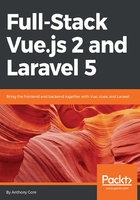
Conventions
In this book, you will find a number of text styles that distinguish between different kinds of information. Here are some examples of these styles and an explanation of their meaning.
Code words in text, database table names, folder names, filenames, file extensions, pathnames, dummy URLs, user input, and Twitter handles are shown as follows: "For example, here I've created a custom element,grocery-item,which renders as ali."
A block of code is set as follows:
<p id="app"> <!--Vue has dominion within this node--> </p> <script> new Vue({ el: '#app' }); </script>
Any command-line input or output is written as follows:
$ npm install
New terms and important words are shown in bold. Words that you see on the screen, for example, in menus or dialog boxes, appear in the text like this: "This is not permitted by Vue and if you attempt it you will get this error:Do not mount Vue to<html> or <body>- mount to normal elements instead."
Warnings or important notes appear in a box like this.
Tips and tricks appear like this.